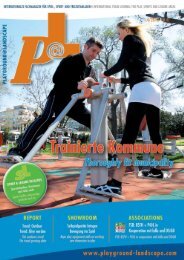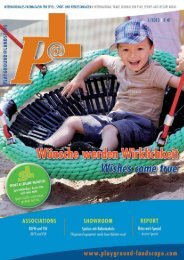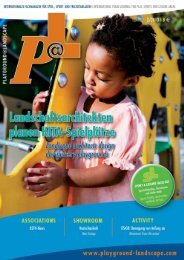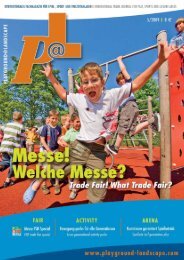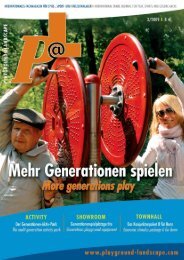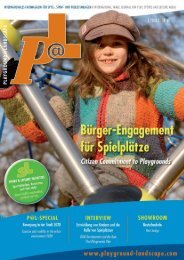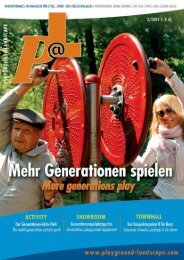Vitalitätstraining für Jung und Alt - Playground@Landscape
Vitalitätstraining für Jung und Alt - Playground@Landscape
Vitalitätstraining für Jung und Alt - Playground@Landscape
Erfolgreiche ePaper selbst erstellen
Machen Sie aus Ihren PDF Publikationen ein blätterbares Flipbook mit unserer einzigartigen Google optimierten e-Paper Software.
COVERSTORY<br />
wirtschaft abgeschlossen werden. Die künftige Programmgestaltung<br />
erfordert eine stärkere Berücksichtigung des Wohnens<br />
als der mit Abstand wichtigsten städtischen Funktion.<br />
P@L: Stichwort „Sozial“: Der GdW hat den Preis „Soziale<br />
Stadt 2010“ ausgelobt. Was steht inhaltlich hinter<br />
diesem Preis? Wer kann mitmachen? Und bis wann?<br />
Lutz Freitag: Mit dem sechsten Wettbewerb zum<br />
"Preis Soziale Stadt 2010" soll erneut das Interesse<br />
einer breiten Öffentlichkeit <strong>für</strong><br />
die sozialen Probleme gestärkt <strong>und</strong><br />
soziale Aktivitäten in den Stadtquartieren<br />
gefördert werden. Akteure<br />
in den Stadtverwaltungen,<br />
der Kommunalpolitik,<br />
Wohnungsunternehmen <strong>und</strong><br />
Wohlfahrtsverbänden sowie<br />
Initiativen: Schulklassen, Bürgervereine,<br />
Organisatoren<br />
von Begegnungsstätten <strong>und</strong><br />
Gewerbetreibende werden<br />
aufgefordert <strong>und</strong> ermutigt, ihre<br />
gewonnen Erkenntnisse <strong>und</strong> Erfahrungen<br />
bei der Förderung des<br />
Miteinanders der verschiedenen<br />
Gruppen von Stadtbewohnern <strong>und</strong><br />
des Zusammenlebens in den Quartieren<br />
bekannt zu machen. Gefragt sind innovative<br />
Projekte, im Sinne des ganzheitlichen Ansatzes der<br />
„Sozialen Stadt“ angelegt sind, wie soziale Konflikte innerhalb<br />
von Nachbarschaften abgebaut oder reguliert sowie der sozialen<br />
Entmischung <strong>und</strong> der krisenhaften Entwicklung von<br />
areas and cities of the old federal states. Evaluation of the programme<br />
should therefore be completed rapidly and involve the housing<br />
and real estate industry. The future programme schedule requires taking<br />
“housing” as the by far most important urban function, much more<br />
strongly into consideration.<br />
P@L: Catchword “Social“: The GdW has offered the award<br />
“Social City 2010”. What does this prize involve?<br />
Who can take part and until when?<br />
Lutz Freitag: With the sixth competition to win the "Social City Award<br />
2010", it is intended to promote again the interest of the public at large<br />
for the social problems and social activities in urban neighbourhoods.<br />
Participants in urban administration, community politics, housing<br />
companies and charities as well as initiatives – school classes, citizens<br />
groups, organisers of meeting places and business people - are prompted<br />
and encouraged to let others know about their knowledge and experiences<br />
in the promotion of community life between different groups of<br />
urban dwellers and living together in different neighbourhoods. We<br />
are looking for innovative projects which fulfil all aspects of a “Social<br />
City”, such as how social conflict within a neighbourhood can be<br />
reduced or regulated, as well as ways to combat social segregation and<br />
the critical social development of residential areas while maintaining<br />
successful integration in a sustained way. Projects can be submitted<br />
18<br />
Wohnquartieren begegnet werden kann <strong>und</strong> Integrationserfolge<br />
nachhaltig gesichert werden können. Bis zum 30. Juni<br />
2010 können noch Projekte eingereicht werden. Die Wettbewerbsunterlagen<br />
können unter www.gdw.de abgerufen<br />
werden.<br />
P@L: Neue Wohnformen <strong>für</strong> junge Familien. Service <strong>für</strong><br />
Senioren. Wohnen <strong>und</strong> Arbeiten zusammen. Gute Angebote<br />
schaffen Nachfrage. Welche Angebote <strong>und</strong><br />
welche Konzepte hat der GdW?<br />
Lutz Freitag: Die im GdW <strong>und</strong> seinen<br />
Regionalverbänden organisierte<br />
Wohnungswirtschaft hat sich<br />
schon früh mit der Frage beschäftigt,<br />
welches Wohnangebot in<br />
Zukunft den Anforderungen<br />
des sich ständig wandelnden<br />
Marktes gerecht wird <strong>und</strong> wie<br />
sich voraussichtlich die Wohnwünsche<br />
der Menschen im<br />
kommenden Jahrzehnt entwickeln<br />
werden. Die GdW-Studie<br />
„Wohntrends 2020“ zeigt deutlich:<br />
Die Wünsche der Mieter differenzieren<br />
sich immer deutlicher, das<br />
Wohnen wird ständig vielfältiger.<br />
Auf entspannten Märkten wird der energetische<br />
Standard der Wohnung zu einem Nachfragekriterium.<br />
Auch die Wohnungsnachfrage der<br />
Senioren wird vielfältiger, „das“ Seniorenwohnen gibt es nicht<br />
mehr, Serviceleistungen <strong>und</strong> elektronische Unterstützungssysteme<br />
werden an Bedeutung gewinnen. Darüber hinaus<br />
Foto: Photocase/Cydonna<br />
by June 30, 2010. Documentation is available at www.gdw.de.<br />
P@L: New housing types for young families. Service for senior<br />
citizens. Living and working together. Good offers create demand.<br />
Which offers and which concepts are provided by the GdW?<br />
Lutz Freitag: : The housing industry organised within the GdW and its<br />
regional associations, began to consider at a very early stage the question<br />
of which housing offer will satisfy the demands of the continually<br />
changing market in future, and how the housing demands of the population<br />
can be expected to develop in the coming decade. The GdW study<br />
“Living trends 2020” clearly shows that the wishes of people living in<br />
rented accommodation differ increasingly and that housing is becoming<br />
increasingly varied. In relaxed markets the energetic standard of an<br />
apartment becomes a demand criterion. Demand for accommodation<br />
for senior citizens is also becoming more varied as there is no longer just<br />
one type of old people’s accommodation.<br />
Services and electronic support systems will gain in importance. In addition,<br />
safety measures in living quarters – first and foremost inexpensive<br />
solutions – will be in greater demand. Expectations with regard to<br />
multimedia equipment in an apartment go beyond a broadband connection,<br />
a separate “home office” is becoming a demand criterion and<br />
an apartment is increasingly becoming a care and health location.<br />
A barrier-free living environment will also become a demand factor.



